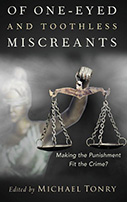Of One-Eyed and Toothless Miscreants: Making the Punishment Fit the Crime?

Author: Michael Tonry
Publisher: Oxford University Press, 2020. 249 pages.
Reviewer: David Schultz ǀ June 2022
The Old Testament talks of “an eye for an eye.” The Mikado declares that “the punishment must fit the crime.” Both of these injunctions speak to the basis of proportionality in criminal punishment, declaring that there must be a connection between the crime and what the state inflicts as a result of guilt. On the surface, proportionality seems simple, but as the essays in this book point to, this is a far more complex subject than basic pronouncements indicate.
This collection of essays, by some of the leading scholars on punishment theory, examines the theory and practice of constructing a theory of proportionality in punishment. The takeoff point for the nine essays is asking if a theory of proportionality is possible and, if so, what does it look like? This is the question that Michael Tonry asks at the beginning of the book. He asks, when we think about proportionality, does the idea of equality come into play? By that, are we talking about equal punishments for equal crimes, for equal people, or even equality when it comes to culpability? Tonry sets the tone for the book, as the authors begin to search for a theory of absolute proportionality. But we find that this search for certainty in our understanding of proportionality is rife with many questions.
Richard Lippke asks, what are the anchoring points for proportionality? Should punishment be proportionate to the crime? Is proportionality measured in terms of relativity to a model or median offender or to a specific real one? Matt Matravers asks if context changes proportionality? Crimes committed in different contexts, otherwise the same, should that merit similar punishments? He also asks if proportionality should be assessed in a comparative or non-comparative fashion? By that, in deciding whether a punishment is proportionate and fair, do we look across offers to see if they are treated the same, or is there some basic anchor that can employed at an individual-level to decide if a person is being punished correctly?
Julian Roberts asks, how should time affect proportionality? By that, perhaps specific crimes can be treated one way at a certain point in history when they are viewed as more or less serious, but perhaps punished differently or with a “different proportion” at a later time when circumstances change? For example, could long punishments for drug offenses be seen as proportional at one time in history, but not in other periods? Or if individuals who offended a long time ago but are caught and punished years later, should the passage of time and the changing character of the offender affect the punishment? This is the question that Adam Kolber asks. Another issue for Kolber is whether proportionality is determined by the specific deed or by many bad acts committed by one person over time, thereby raising questions about repeat offender and enhanced punishment rules. Finally, Jesper Ryberg asks whether there are objective and subjective components to deciding proportionality, Douglas Husak asks what factors are salient to deciding how to assess the serious of a crime, and Duus-Otterström wants to know if it is possible to have relative or absolute weights or measures for defining what we mean by proportionality. A final chapter by Tapio Lappi-Seppälä examines changing trends in sentencing in the Nordic states as they have wrestled with the application of this concept.
Until reading this book, one may never realize how difficult it has been to agree upon what proportional sentencing really means. In part, this is the virtue of the book to point out its complex nature, especially as applied and relative to the dangers in getting it wrong. Ever since Jeremy Bentham penned The Principles of Morals and Legislation, there has been a belief that punishment could be an exact science of calculation. This book points to that impossibility. The other misguided aspect of the theory of proportionality is the belief that there is some absolute trans-historical absolute theory of proportionality and such an Archimedean point can be found. There is no such thing. Proportionality may not be a hard edge, crisply defined concept. It may be more fuzzy, with various factors taken into consideration. There may also be no absolutely perfect application of proportionality with many factors affecting what we deem to be proportionate.
The point here is that the authors here are correct that, in lacking some theory of punishment, we fall into the problem of being arbitrary and capricious in terms of punishment and we need to confine the state’s discretion. Yet the search they are on for a level of certainty and measure in defining proportionality simple may not be possible, or if it is, some of the arguments of distinctions made in the book may be arguments about things that may matter in theory, but when it comes to practice, as the philosopher Charles Pierce one exclaimed, they really do not matter. At best, punishment and proportionality is like grading papers as one essay here suggested. We can achieve rough approximation, but not absolute certainty.
David Schultz is Hamline University Distinguished Professor Political Science, Legal Studies, and Environmental Studies in Saint Paul, Minnesota, USA.


